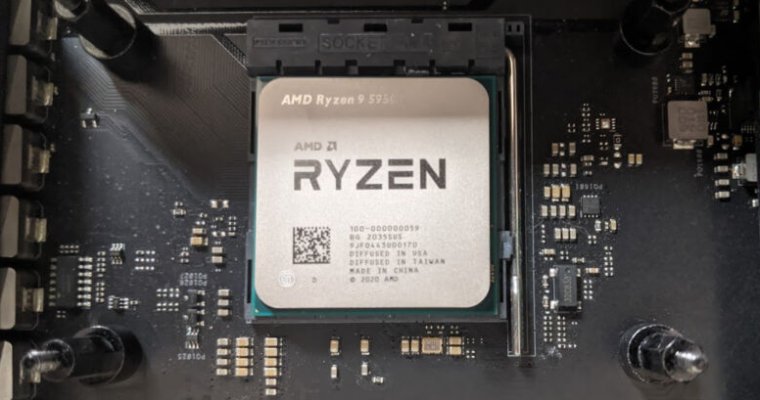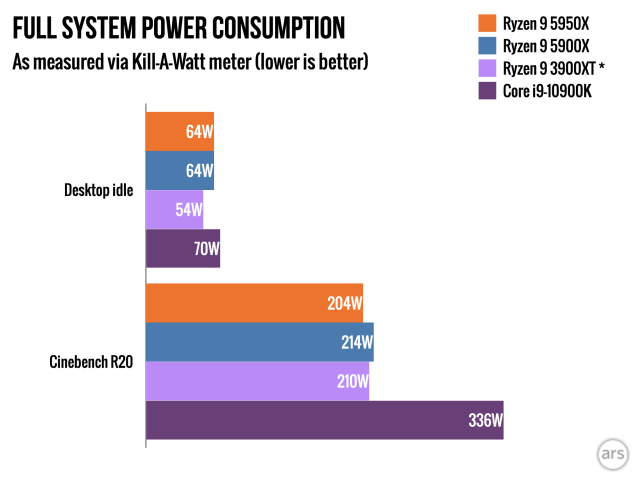
| Specs at a glance: Ryzen 5000XT CPUs, as tested | |
|---|---|
| OS | Windows 10 Professional |
| CPU | Ryzen 9 5950X (16c/32t) Ryzen 9 5900X (12c/24t) Ryzen 9 3900XT (12c/24t)—$455 at Amazon |
| RAM | 2x 32GB Corsair Dominator Platinum RGB DDR4 3200—$180 ea at Amazon |
| GPU | MSI GeForce 2060 RTX Super—formerly $450 at Amazon |
| HDD | Samsung 860 Pro 1TB SSD—$200 at Amazon |
| Motherboard | ASUS ROG Crosshair VIII Hero (Wi-Fi)—$380 at Amazon |
| Cooling | NZXT Kraken X63 fluid cooler with 280mm radiator—$150 at Newegg |
| PSU | EVGA 850Ga Modular PSU—$140 at Amazon |
| Chassis | Primochill Praxis Wetbench test chassis—$200 at Amazon |
| Price as tested | ≈$1,500 as tested, excluding CPU |
A month ago, AMD announced the arrival of the Zen 3 desktop CPU architecture. The announcement included new AMD internal benchmarks that implied Intel had lost its last desktop performance trophy—pure single-threaded performance.
Last week, Ars got samples of the two highest-end models in the new CPU lineup—the $800, 16-core/32-thread Ryzen 9 5950X, and the $550 12-core/24-thread Ryzen 9 5900X. And we can confirm most of AMD's benchmark claims—IPC has improved, along with both single and multi-threaded performance, across the board, beating Intel soundly on nearly all fronts.
The only quibble we have with AMD's claims regards power consumption, not performance—and to be fair, it's almost certainly not AMD's fault. The system's desktop idle power consumption increased about 10W—but the increase affected our older Ryzen 9 3900XT CPU, as well as the two new Zen 3 parts. Knowing that, we expect the increase comes from the mandatory BIOS upgrade we had to perform on the ROG Crosshair VIII Hero motherboard, rather than the new CPUs themselves.
Multi-threaded benchmarks
-
Cinebench R20 multi-threaded demonstrates the healthy IPC bump Zen 3 offers over Zen 2.Jim Salter
-
Passmark confirms the big IPC boost we already saw in Cinebench. The drubbing Intel's i9-10900K takes in this more general-purpose benchmark is downright embarrassing.Jim Salter
-
For the most part, Geekbench for once agrees with Passmark and Cinebench—although it still tends to flatten the impact of higher core counts.Jim Salter
Regardless which multi-threaded benchmark you choose, you'll see a familiar relationship between these parts—AMD packs on a sizable performance boost from generation to generation, and Intel languishes behind significantly.
As usual, these differences are magnified the most in Passmark, and the least in Geekbench—but they're impossible to ignore, and Intel's increasingly elderly i9-10900K is starting to look downright embarrassing. Intel will need to pull a pretty impressive rabbit out of its hat with its next generation of gaming CPUs if it doesn't want to hemorrhage marketshare, as AMD continues to both release faster CPUs, and release new iterations more frequently.
Single-threaded benchmarks
-
AMD wasn't kidding about single-threaded performance—we pulled record-breaking 630 scores on both the 5950X and 5900X.Jim Salter
-
Passmark single-threaded results also blow past the i9-10900K, though by a somewhat narrower margin than Cinebench R20 showed.Jim Salter
-
Geekbench 5 confirms the single-threaded story told by Cinebench and Passmark, with a significant lead granted to the two Zen 3 CPUs.Jim Salter
Our single-threaded tests solidly confirm AMD's claims from the Zen 3 launch—Intel's days of dominating single-threaded benchmarks are over, at least for now. All three of our single-threaded benchmarks show a healthy lead for the two new Zen 3 CPUs over Intel's top-performing single-threaded i9-10900K CPU.
As always, we caution most people not to get too excited about pure single-threaded results—multi-threaded performance is not equivalent to single-threaded multiplied by the number of active threads, and significant activity on other threads will reduce performance from the levels you see here.
That said, single-threaded performance can be more important in a gaming console setting, where CPU activity can be more tightly controlled than it typically is in a desktop PC. Zen 3's big gains here won't help Playstation 5 or Xbox Series X—both of which will feature CPUs based on the older Zen 2 architecture—but we suspect neither Sony nor Microsoft is regretting its decision to back Team Red, all the same.
Gaming benchmarks
-
3DMark's Time Spy Extreme CPU test shows a healthy performance bump for both Zen 3 CPUs, heavily implying they're the CPUs you'll want for 4K gaming.Jim Salter
-
The simpler Time Spy CPU test has the i9-10900K and the 5950X at a dead heat, with the 5900X trailing almost imperceptibly behind. This is probably a better benchmark for 1440P or 1080P gaming.Jim Salter
3DMark's more gaming-specific CPU tests confirm what we already saw from general-purpose benchmarks—AMD's Zen 3 architecture isn't giving anything up to Intel. Time Spy Extreme—which models 4k gaming performance and can take advantage of more cores and more advanced CPU instructions than Time Spy—delivers a healthy lead for 5900X and 5950X over both the older 3900XT and Intel's i9-10900K.
The simpler, non-Extreme Time Spy benchmark is likely a better fit for gaming up to 1440p, and Intel does much better there, running a basically dead heat with the 5950X and 5900X and slightly outperforming the older 3900XT. You're not likely to see better gaming performance out of the i9-10900K than the AMD parts, even at lower resolutions—but if you're budget-constrained, find a really great deal on the Intel parts, and don't care about 4K gaming, it won't hurt your framerates.
Power and heat

Where the i9-10900K will hurt you, unfortunately, is in heat generation and power consumption. The Intel CPU pulls 100W more power—and generates 100W more heat—than either the old or new Ryzen 9 CPUs.
Our test results largely confirm AMD's claims of increased power efficiency with Zen 3—despite having a 200MHz higher clockrate and 25-percent more cores and threads, Ryzen 9 5950X consumed a little less power under load than last generation's Ryzen 3900XT. We actually saw slightly lower power consumption from the 5950X than the smaller 5900X, but we suspect that's a quirk of individual CPUs rather than an overarching difference between models.
We saw a pretty significant increase in desktop idle power consumption, from 53W to 64W—but the increase doesn't appear to be a result of the CPUs themselves. We needed to flash our ROG Crosshair VIII Hero motherboard with a brand-new BIOS that wasn't yet publicly available in order to support the two new CPUs. After noticing the increase in desktop idle power consumption, we swapped back to the Ryzen 9 3900XT and saw an even larger increase in power draw on that processor.
We suspect that the increase in idle power consumption will be addressed in future publicly available BIOS versions. We also suspect that very few of the people who want a Ryzen 9 or Core i9 CPU are going to let the difference between 53W and 64W bother them much.
Conclusions
AMD's new desktop processor lineup is a pretty straightforward story—the company promised higher multi-threaded and single-threaded performance without a corresponding sacrifice in efficiency and then delivered on those promises.
Beginning with the 3900XT, AMD decided not to provide OEM coolers with Ryzen 9 parts—and the company stuck with that decision with the new 5900X and 5950X. Although some readers have complained about the lack here, AMD justifies it with claims that data shows very few customers at this processor level stick with the OEM cooler anyway. We see no reason to doubt AMD there.
With the release of these new Zen 3 processors, Intel fans lose their last big bragging right—single-threaded performance. Intel is now behind AMD on performance, power efficiency, and even release count on desktop CPUs—its last gaming CPU was the i9-10900K, released in May. AMD is now two releases ahead, with the 3900X and 3900XT in July, and 5900X and 5950X today.
Meanwhile, Intel's next-gen Rocket Lake isn't expected until sometime in 2021—and it's widely expected to remain on Intel's 14nm process, although using features backported from the 10nm Sunny Cove architecture. We're also expecting Rocket Lake to top out at only eight cores, compared to Comet Lake's ten.
Intel's newest Tiger Lake mobile CPUs are great performers despite their similarly low core count, and it's possible that Rocket Lake will enjoy similar success next year—but we aren't betting on it. We suspect that Intel's difficult times on the desktop aren't going to be over any time soon.
The good
- 200MHz higher clockrate in 5950X over 3900XT
- Higher IPC to go along with the higher clockrates
- Significant single-threaded performance improvement
- Mostly unchanged power profiles, well below Intel's
- Better Time Spy Extreme CPU test results than Intel's
- Supported on B550 motherboards with BIOS upgrade
The bad
- "Only" equivalent Time Spy (non-Extreme) CPU results with Core i9-10900K
- Will likely still be harder to find in pre-built OEM PCs
The ugly
- Intel's current position on the desktop
November 05, 2020 at 09:00PM
https://ift.tt/3pcrhQK
AMD's Zen 3 CPUs are here—we test the blistering-fast 5900X and 5950X - Ars Technica
https://ift.tt/2YXg8Ic
Intel

No comments:
Post a Comment